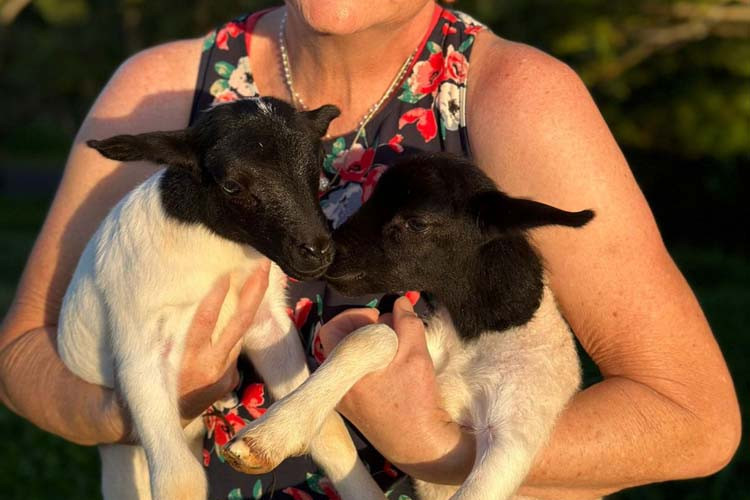On The Land
25 January, 2024
Unique sheep farming initiative for Millaa
SHEEP in Millaa Millaa are a rare and unexpected sight, prompting locals and visitors alike to look twice. However, they will now become a more common sight in the area as a result of an innovative venture.

Dilly Dally Farm owners Jen and Paul Musetti said they opted for Dorper sheep over cattle due to the smaller size and easier handling of the sheep.
“We originally purchased two ewes from friends in Malanda,” Jen said.
“They have been sheep farming in different regions of Australia for over 60 years.”
The Musettis' foundation flock currently comprises of five adults and three lambs, with the flock expected to proliferate in the very near future due to the unique breeding attributes of the Dorper sheep.
Their current focus is on rapidly expanding their foundation flock with the goal of reaching 30 animals in the near future.
Developed in South Africa in the 1930s from cross breeding Blackhead Persian ewes with a Dorset Horn ram, the Dorper was introduced into Australia in 1996 and today is one of the fastest growing sheep breeds in the country.
It is now a widely used breed of sheep in the Australian prime lamb industry for both domestic and export quality sheep meat.
Currently, around 14% of the Australian sheep flock has some content of Dorper genetics and this percentage is increasing annually.
Independent consultancy research consistently shows the Dorper to be unsurpassed in low cost of production across a range of climatic conditions.
“Dorper sheep are meat sheep and are better suited to wetter areas,” Jen said.
“By working with them we have found that they are easy to train and manage.
“The Dorper is low maintenance and naturally sheds its wool.”
Boasting animal welfare benefits, Dorpers do not require shearing, mulesing, crutching or tail docking with these operations being associated with flystrike control.
Instead, the breed is spared from developing flystrike and does not need preventative treatments.
Being very disease resistant, it also has a natural skin pigmentation which protects it from skin cancers seen in many other breeds in Australia. This attribute is particularly important in the tropics.
“One of the many advantages of Dorper sheep is that they are very hardy,” Jen said.
“Our facilities prevent footrot which is a common challenge with rearing and managing sheep.
“The topography of our farm allows for good drainage and assists with preventing this as well.
“As sheep have smaller hooves compared to cattle, there is less pugging and compaction of the ground especially during the wetter times of the year.”
The Dorper is very maternal, producing fast growing, vigorous lambs.
It is polyoestrous which means it can breed continually, with no defined season.
One of the most fertile of all sheep breeds, it has a lambing interval of only eight months and can sometimes produce three lambs in two years.
Lambing percentages in excess of 150% (2.25 lambs per annum) are possible and well over 100% is readily achievable in most areas.
Given their polyoestrous characteristics, short breeding intervals and fast growing potential, the flock size of Dorpers increases more quickly than with most other sheep breeds.
They are excellent mothers and are protective of their young.
Multiple births are common in the breed, with Jen and Paul already having had triplets born on their farm.
The Dorper ewe produces a large quantity of milk, aiding lamb survival and early growth.
Lambs are extremely mobile at birth and survival rates are high, with them having the ability to graze from an early age.
They are non-selective grazers and grow rapidly to attain a high weaning weight.
“You need to be mindful of predators such as wild dogs and wedge tail eagles for the lambs,” Jen said.
“Protective fencing or protection dogs such as Maremmas are needed.”
Hailed as both an economical breed to produce and a profitable one to sell, Dorpers have excellent feed utilisation and conversion ratios.
Purebred rams reach a liveweight of between 90kg to 120kg and ewes 50kg to 80kg.
Often called the “Angus of sheep”, Dorper lamb is a high-quality, premium, lean meat which is highly regarded in gourmet circles.
It is also popular for its exceptional qualities such as low-fat scores and ideal meat-to-bone ratios.
Lamb meat is highly regarded for being an excellent source of protein, iron, vitamin B and immune boosting zinc, as well as containing anti-inflammatory omega-3 fatty acids.
“They produce a high quality carcase which has excellent carcase conformation and fat distribution,” Jen said.
“The meat is delectable, so tender and juicy.”


